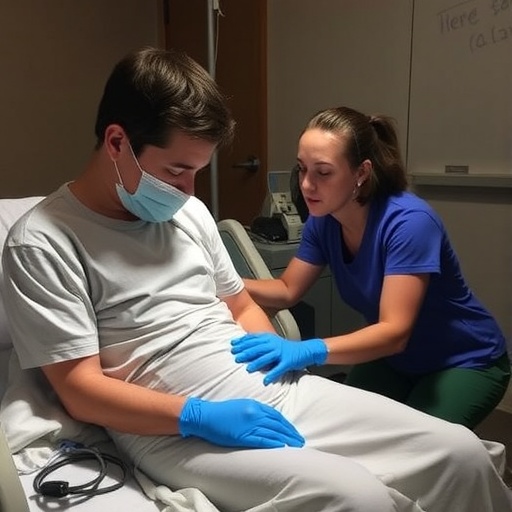In the evolving landscape of pediatric anesthesia, a critical and often debated topic has surfaced regarding the optimal positioning of very young patients during sedation. The question posed by researchers Chin-Kang Pac-Soo and Dandan Ma — “Should we sedate very young patients in the lateral position?” — has ignited a nuanced discussion within the pediatric and anesthesiology community. Their recent publication in the World Journal of Pediatrics delves into the complex interplay between sedation protocols, patient safety, and physiological considerations that underscore this delicate decision.
Sedation in pediatric patients, particularly neonates and infants, demands an intricate balance. These patients present unique anatomical and physiological characteristics distinct from older children and adults, such as immature respiratory control, variable airway anatomy, and increased susceptibility to airway obstruction. The decision to position these vulnerable patients laterally, as opposed to the more traditional supine position, is not merely a matter of convenience but involves careful evaluation of airway patency and risk mitigation.
One of the primary arguments supporting lateral positioning during sedation centers on the maintenance of airway patency. The lateral position can facilitate spontaneous drainage of secretions and reduce the incidence of airway obstruction, a known complication in sedated infants. Unlike older children, the very young possess a relatively large tongue in proportion to the oral cavity, prone to cause airway collapse when muscle tone decreases under sedation. Placing the patient laterally may counterbalance this anatomical predisposition by allowing gravity to assist in keeping the airway open.
.adsslot_zMvSc6TeHG{ width:728px !important; height:90px !important; }
@media (max-width:1199px) { .adsslot_zMvSc6TeHG{ width:468px !important; height:60px !important; } }
@media (max-width:767px) { .adsslot_zMvSc6TeHG{ width:320px !important; height:50px !important; } }
ADVERTISEMENT
Moreover, the lateral position has been historically applied in cases of airway surgery or procedures necessitating scrutiny of upper respiratory pathways. Extending this practice to routine sedation scenarios demands rigorous assessment of its benefits against potential downsides. Pac-Soo and Ma’s correspondence underscores the paucity of high-quality randomized controlled trials that definitively declare one position superior in terms of safety and efficacy for sedated infants.
Pac-Soo and Ma highlight the need to weigh these physiological nuances against the context of the procedural requirements and the expertise of the clinical team. In facilities with comprehensive monitoring and skilled anesthesia providers, lateral sedation might offer advantages that enhance patient safety. Conversely, scenarios that lack such robust support systems may favor the familiarity and logistical simplicity of the supine position.
Another compelling aspect of this debate is the potential psychological impact on caregivers and families observing sedation approaches. The lateral position, which may appear unconventional, could provoke concerns, underscoring the importance of incorporating clear communication and education into sedation protocols. Transparency about the rationale for positioning and associated risks is essential to maintaining trust and ensuring informed consent.
Pharmacological considerations also intertwine with positional choices. Sedative agents such as dexmedetomidine and midazolam affect central nervous system activity differently, influencing muscle tone, respiratory drive, and airway reflexes. The lateral position may either mitigate or exacerbate sedative-related airway compromise depending on these drug effects, an interaction that demands further empirical elucidation.
The intricate balance of oxygenation and ventilation during pediatric sedation further complicates this clinical equation. Pulse oximetry and capnography are vital in continuous assessment; however, the lateral position can affect the accuracy and interpretation of these monitoring modalities, hence clinical teams must maintain heightened vigilance. Adjustments in sensor placement and monitoring techniques may be required to adapt optimally to lateral positioning.
Pac-Soo and Ma also draw attention to rare but serious complications, such as aspiration, which sedation protocols aim to prevent. The lateral position theoretically reduces the risk by facilitating drainage of gastric contents and secretions away from the airway. Nevertheless, this benefit is contingent upon precise execution of sedation and positioning protocols to avoid inadvertent head rotation or neck flexion that could negate airway protection.
Incorporating the lateral position into standard sedation practices may also necessitate revisions in anesthesia training curricula. Practitioners must become adept at patient handling, airway maneuvers, and emergency interventions tailored to lateral sedation scenarios. Simulation-based training could play a pivotal role in preparing anesthesiologists and nursing staff to respond promptly to position-specific challenges.
From a research standpoint, the letter by Pac-Soo and Ma serves as a catalyst for in-depth investigations. Prospective studies comparing lateral versus supine sedation with comprehensive endpoints—including oxygen saturation, airway events, hemodynamic stability, and procedural success—are imperative. Additionally, subgroup analyses according to age, comorbidities, and sedative regimens could refine guidelines for personalized sedation practices.
Technological advancements hold promise in enhancing safety in lateral sedation. Innovations such as automated patient positioning systems, integrated multi-parameter monitoring platforms, and artificial intelligence-driven prediction models could facilitate real-time adjustments and early detection of complications unique to lateral sedation.
Ethical considerations must not be overlooked. The adoption of lateral sedation protocols should be grounded in robust evidence to ensure patient welfare and uphold medical standards. As with any clinical innovation, transparency in reporting adverse events and outcomes is critical to iteratively refine practices and inform consensus guidelines.
The dialogue ignited by Pac-Soo and Ma’s inquiry epitomizes the dynamic nature of pediatric anesthesia, where evolving evidence continuously informs best practices. Sedating very young patients laterally may represent a shift toward personalized, physiology-informed sedation strategies, but it also challenges established conventions and demands a multi-dimensional appraisal.
In conclusion, whether the lateral position should become routine during sedation for very young patients hinges upon a confluence of factors—anatomical, physiological, pharmacological, technical, and ethical. Pac-Soo and Ma’s reflection invites the pediatric anesthesia community to critically evaluate existing protocols and embrace a research agenda poised to optimize sedative care tailored for the youngest and most vulnerable patients.
Subject of Research: The exploration of optimal patient positioning (lateral vs. supine) during sedation of very young pediatric patients, focusing on airway safety, physiological implications, and procedural outcomes.
Article Title: Should we sedate very young patients in the lateral position?
Article References:
Pac-Soo, C.K., Ma, D. Should we sedate very young patients in the lateral position?. World J Pediatr 21, 550–551 (2025). https://doi.org/10.1007/s12519-025-00930-6
Image Credits: AI Generated
DOI: https://doi.org/10.1007/s12519-025-00930-6
Tags: airway management in neonatesairway patency during sedationanatomical considerations in pediatric anesthesialateral position advantages in sedationoptimizing sedation for very young patientspediatric anesthesia safetypediatric anesthesiology research insightspediatric sedation best practicesrespiratory control in young patientsrisks of airway obstruction in infantssedation position impact on patient safetysedation protocols for infants





